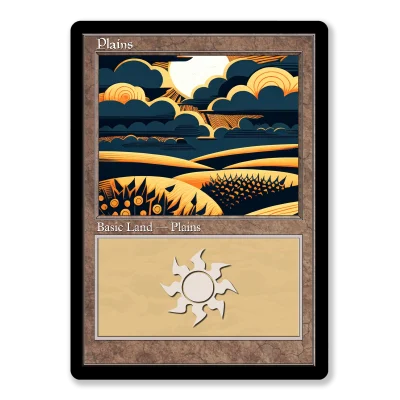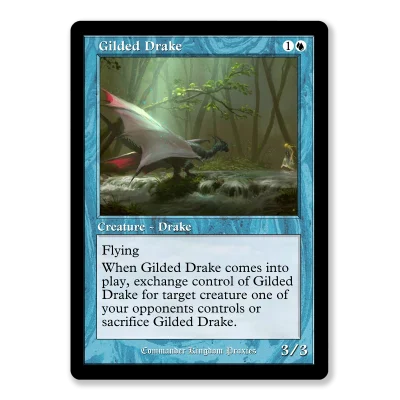“Regenerate [permanent]” means: “The next time [permanent] would be destroyed this turn, instead remove all damage on it, tap it, and remove it from combat if it’s an attacking or blocking creature.” Abilities that trigger from damage being dealt will still trigger, even if the permanent regenerates.
Magic: The Gathering (MTG) has a long history of mechanics that protect creatures from harm. One of the most iconic of these is regeneration. Although newer sets have moved away from it, regeneration once held a firm place in many strategies. Some players still enjoy the old-school charm of tapping a creature to keep it alive, and many casual tables continue to see regeneration effects in action. This article explores how regeneration works, when it applies, and why it adds an interesting twist to combat and removal. We will also look at the nuance of certain rules, the difference between activated ability and static ability, and how regeneration has been replaced or overshadowed by newer effects.
Players utilize a creature’s regeneration ability to prevent their creatures from being destroyed during combat or when targeted by spells like Shock. This strategic use of regeneration allows the creature to survive interactions with other player actions.
Rules for Regeneration
The activation of regeneration is subject to specific rules and limitations:
- Activation Timing: Regeneration must be activated before the creature is destroyed, making it a preemptive measure rather than a reactionary one. It cannot resurrect a creature that has already been destroyed.
- Limitations: Regeneration shields do not protect against exile, reduction of a creature’s toughness to 0, effects that specifically state “cannot be regenerated,” or moving the creature to another zone such as the player’s hand. It is also ineffective against sacrificing, as this action does not involve destruction by damage.
- Combat Implications: A regenerated creature is removed from combat, which can alter the outcome of combat by preventing further damage to and from the creature for that turn. However, if the creature was blocking, it still deals combat damage before regeneration occurs unless specific abilities like trample are involved.
- Token Regeneration: Tokens can be regenerated just like other creatures, allowing them to stay on the battlefield instead of being removed upon taking lethal damage. However, tokens have unique interactions with state-based effects and zones that can affect their longevity post-regeneration.
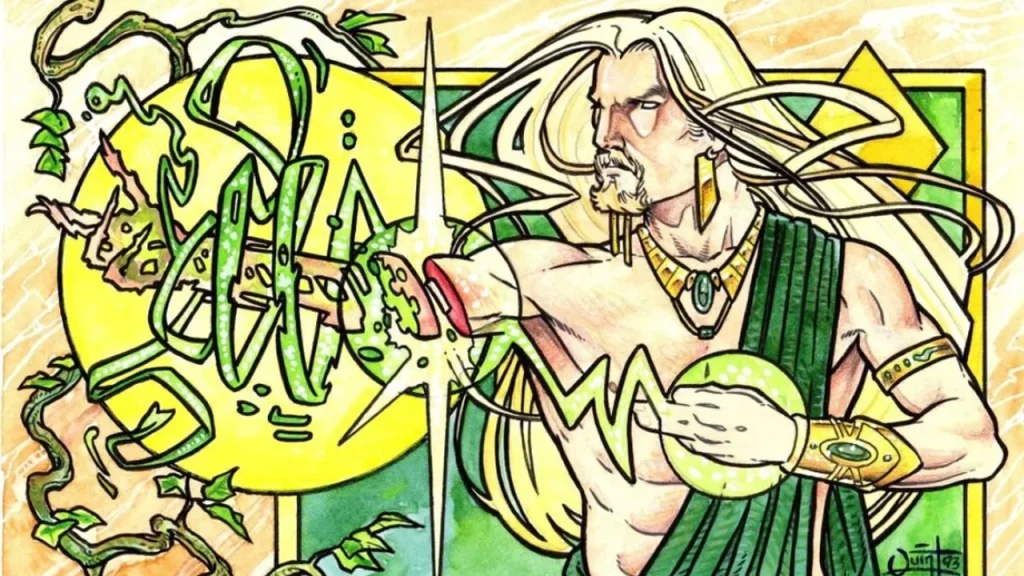
What Is Regeneration?
Regeneration is a replacement effect that replaces destruction. When a permanent, such as a creature, would be destroyed—usually by taking lethal damage or by an effect that says “destroy”—a regeneration shield can step in and save it, provided you created that shield in advance. The general idea is that the creature avoids the destruction event by tapping, getting all damage marked on it removed, and becoming removed from combat (if it was attacking or blocking).
Some spells or abilities say, “Regenerate target creature.” Others appear on creature cards as an activated ability (for instance, “{G}: Regenerate this creature”), which means you pay a certain mana cost or do something else the ability asks, and you get a regenerate effect for that creature, preventing it from dying when targeted by destruction effects or lethal combat damage. There are even older cards that feature a static ability that essentially “regenerates” that creature in certain circumstances. In most of those older cards, the text might read something like: “Whenever this creature would be destroyed, instead tap it, remove all damage from it, and remove it from combat.” That’s basically the reminder text for how regeneration works.
It’s important to note that regeneration only replaces destruction. It doesn’t stop other forms of removal like exile or “put on top of your library.” It also doesn’t save a creature from having zero or negative toughness, or from effects that say “cannot be regenerated.” Plus, if a card says “destroy target creature. It can’t be regenerated,” you don’t get to use a regeneration shield to save that creature.
The History of Regeneration
Regeneration made its debut in the Limited Edition (First Edition) set back in 1993, marking one of the earliest keyword abilities in Magic: The Gathering. Designed by Richard Garfield, the creator of MTG, regeneration was intended to offer a strategic way for creatures to survive damage and remain on the battlefield. This mechanic quickly became a staple, especially in green and black decks, where it provided a reliable means of protecting key creatures from destruction.
Over the years, regeneration has seen several updates to improve its clarity and playability. One significant change came with the Sixth Edition rules overhaul, which aimed to simplify many of the game’s mechanics, including regeneration. This rework made it easier for players to understand when and how to use regeneration shields effectively.
Despite its complexity, regeneration maintained its popularity for many years. Players appreciated the tactical depth it added to the game, particularly in decks that relied on keeping creatures alive through thick and thin. However, as the game evolved, Wizards of the Coast introduced more straightforward mechanics like indestructible, which offered similar protection without the intricate timing and rules interactions. As a result, regeneration has become less common in newer sets, though it remains a beloved part of MTG’s rich history.
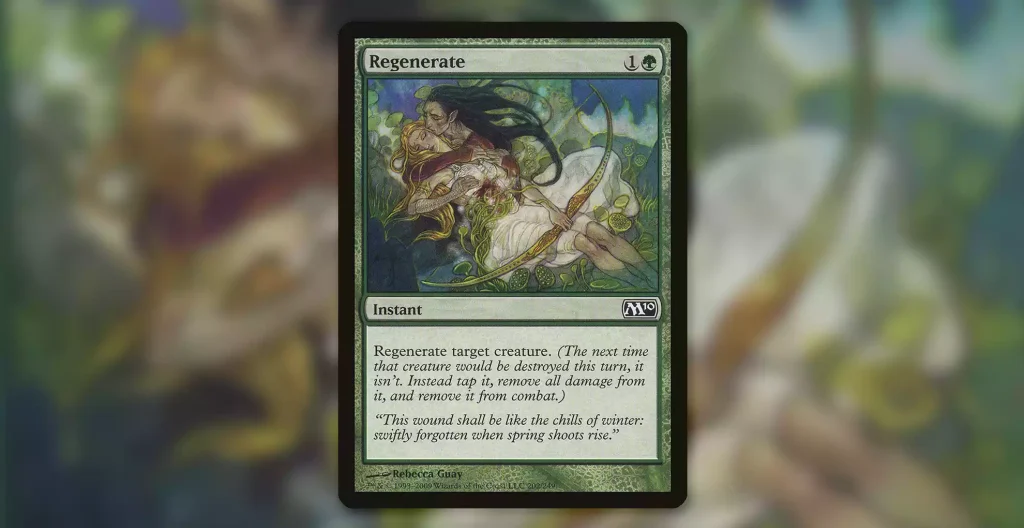
The Basics of Regeneration
A regeneration shield is a lot like a one-use protective bubble. You put up this shield before a destruction event occurs. It’s not something you can do in response to the actual moment of destruction once it’s about to happen. In other words, you have to activate or cast the ability or spell that grants regeneration at a time when you have priority, or under some condition spelled out by a static ability regenerates text.
Let’s say you have a 2/2 creature with “{G}: Regenerate this creature.” If your opponent casts “Shock,” which deals 2 damage to your creature, you can respond to that Shock by paying the regenerate mana cost (in this case, one green mana). Then, if no one has a way to prevent regeneration shields, your creature will have a shield on it. When Shock resolves, the game sees that 2 damage is being dealt, enough to kill your 2/2. But instead of the creature going to the graveyard, the regeneration shield kicks in. The creature removes all damage marked on it, taps, and is removed from combat if it was in combat. If it wasn’t attacking or blocking, it simply remains on the battlefield, tapped and safe.
Keep in mind that a regenerated creature doesn’t become summoning sick again. That rule only applies if something specifically says the creature becomes a “new object,” or if it leaves the battlefield and returns. Regeneration doesn’t cause zone changes, so it doesn’t reset summoning sickness.
Regeneration Effect and Counters
When a creature’s regeneration ability is activated, it creates a regeneration shield—a one-time protective barrier that prevents the creature from being destroyed by damage. This shield acts as a replacement effect, stepping in to save the creature at the critical moment when it would otherwise be destroyed.
If a creature with a regeneration shield is dealt damage that would be lethal, the shield activates. The creature is tapped, all damage marked on it is removed, and it is removed from combat if it was involved in any. Importantly, the creature does not leave the battlefield, so any counters, enchantments, or equipment attached to it remain in place. This continuity can be crucial in maintaining the creature’s strength and abilities.
However, it’s essential to understand the limitations of regeneration. The shield does not protect against effects that do not involve destruction, such as being sacrificed or exiled. These effects bypass the regeneration shield entirely, meaning the creature will still be lost despite the shield. Knowing when and how to use regeneration shields effectively can make a significant difference in gameplay, but it’s equally important to recognize their boundaries.

Timing Is Everything
Regeneration can feel clunky for new players because you need to activate it before the creature actually dies. A replacement effect must be set up in advance. This leads to some interesting timing scenarios.
During Combat
If you suspect your creature will take lethal damage in combat, you might hold up mana to pay the regenerate cost. Maybe you’re in the combat phase, and your 3/3 is blocking your opponent’s 5/5. You go to the declare blockers step and declare your 3/3 as the blocking creature. Now, you can hold priority right before combat damage is dealt and pay the regenerate mana cost to give your 3/3 a regeneration effect.
When combat damage happens, your 3/3 is dealt 5 damage—enough to kill it. But the shield is already in place, so the 3/3 would be destroyed but regenerates instead. The game sees the shield, uses that alternate effect, and your 3/3 is removed from combat, tapped, and has all damage removed from it. It doesn’t get to deal more damage that combat or block again in that turn, but it remains on the battlefield.
Outside of Combat
If a card like “Doom Blade” targets your creature, you can’t wait until it’s about to die to pay for the regenerate ability. Instead, you must do it before the spell or ability resolves. If you have a creature with “{1}{G}: Regenerate this creature,” you can respond to “Doom Blade” by paying {1}{G}. That sets up the regeneration shield. When “Doom Blade” resolves, it tries to destroy your creature, but the creature regenerates. If you had no mana or forgot to respond, the creature would simply die.
Multiple Shields
Some spells or abilities might allow you to set up more than one instance of regeneration in a turn. Each time you pay the cost or do what’s required, you get another shield. If something tries to destroy the creature, you lose one shield but keep the others. If, for some reason, the creature is targeted by multiple lethal effects in the same turn, it can survive multiple times if you have enough shields. However, note that most players rarely stack multiple shields unless they expect multiple events of destruction in a short span.
Combat Interactions and Being “Removed from Combat”
When a creature regenerates, one of the standard rules is that you remove it from combat. This matters a great deal in the combat phase, especially for an attacking creature. If you regenerate that attacker before damage is dealt, it will still be considered an attacker unless the regeneration effect itself triggers at the exact moment lethal damage would be dealt. In that moment, the creature is effectively saved but is also removed from combat for the remainder of that turn.
If your creature was a blocking creature, it’s still considered blocked, but the regenerated creature is no longer there to deal or receive further damage (unless something unusual happens later in the turn). If your opponent’s creature had trample, it might still assign leftover damage to you. The key takeaway is that once a creature regenerates, it’s out of the fight.
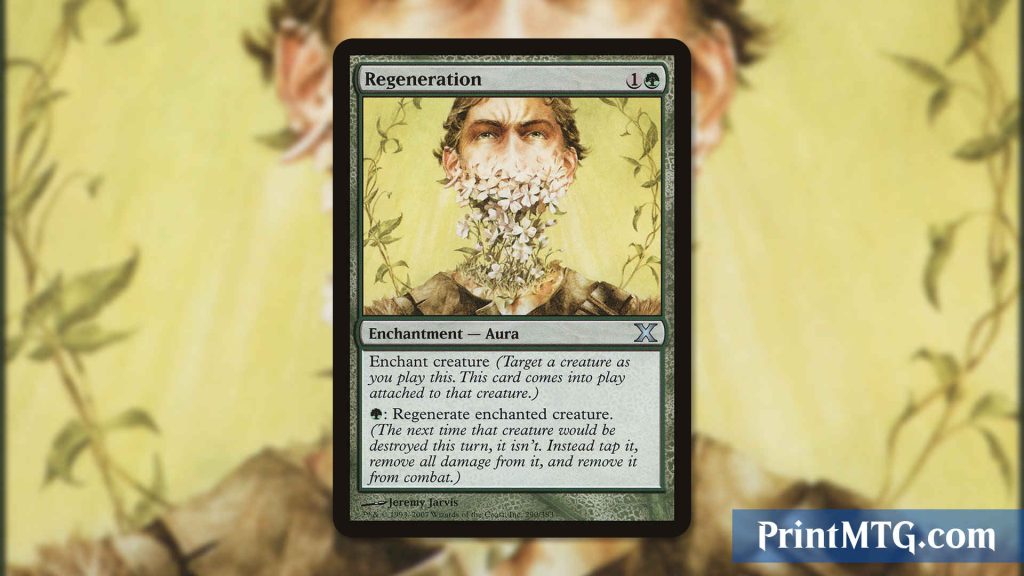
“Destroyed This Turn Instead”: Regeneration vs. Modern Effects
Some modern cards circumvent regeneration. For instance, a card might say “If a creature was destroyed this turn, do X.” Or it might say “Destroy that creature. It can’t be regenerated.” That second clause effectively stops any ability that tries to set up or use a regeneration shield. Also, if an effect says “Exile that creature” or “Sacrifice a creature,” that’s not destruction, so regeneration does nothing to save it.
Wizards of the Coast often replaces old references to regeneration with phrases like “If this permanent would be destroyed this way, instead tap it remove all damage from it” or uses “indestructible” or “shield counters.” The game’s design shifted away from regeneration because it was tricky for many players to understand. It also led to confusing board states, especially under older rules where damage used the stack.
Despite these new solutions, older cards still keep their original text or updated Oracle text that says “Regenerate.” If you own those cards, the rule is still valid: you can pay the regenerate cost, you can save your creature from lethal damage, and you still get to keep it on the battlefield, albeit tapped.
Saving a Creature from -X/-X Effects
Regeneration can sometimes save a creature from -X/-X effects, but its effectiveness depends on the specifics of the situation. If a creature’s toughness is reduced to 0 or less by an -X/-X effect, regeneration will not save it. In this case, the creature is destroyed immediately due to having zero or negative toughness, and the regeneration shield cannot intervene.
However, if a creature’s toughness is reduced but remains above 0, regeneration can be used to save it from destruction. When the creature is dealt damage that would otherwise be lethal, the regeneration shield activates, preventing the creature from being destroyed. The creature is tapped, all damage is removed, and it is removed from combat if it was participating in any.
It’s important to note that while regeneration can be a powerful tool, it is not a guaranteed safeguard against all -X/-X effects. Other effects or subsequent damage could still destroy the creature despite the regeneration shield. Players must carefully consider the timing and context of using regeneration to maximize its protective benefits.

Common Misconceptions
“I Can Respond to the Creature Dying”
A frequent misunderstanding is that you can respond at the exact moment a creature is going to the graveyard. But that’s not how regeneration works. State based effects see that the creature has lethal damage or was instructed to be destroyed, and they send it to the graveyard right away unless a replacement effect (like regeneration) is already in place. You can’t jam a regeneration effect in the middle of a resolving spell or in the middle of damage being applied.
“Regeneration Shields Stop Everything”
They don’t. They only stop destruction from lethal damage or “destroy” effects. They do nothing against forced sacrifice or exile or -X/-X effects that reduce toughness to zero. And if an effect says “destroy target creature and it can’t be regenerated,” the shield is effectively ignored.
“A Regenerated Creature Stays in Combat”
No, the rules specifically say that once the ability regenerates the creature, you remove it from combat. That’s part of how regeneration works. The logic is that the creature is too busy patching itself up to keep fighting this turn.
Sample Scenarios
Shock vs. 2/2 Creature with Regenerate and Lethal Damage
Imagine you have a 2/2 with “{G}: Regenerate.” Your opponent casts “Shock,” which deals 2 damage. You respond by paying {G} to set up the shield. The shock resolves and tries to kill your creature. The shield sees that the permanent would be destroyed. Instead, you tap your creature, remove all damage marked on it, and it remains on the battlefield. The regeneration effect “replaces destruction.”
Combat with a 4/4 and a 2/2 with Deathtouch
You attack with a 4/4. The opponent blocks with a 2/2 that has deathtouch. You see that your 4/4 will take lethal damage from the 2/2 because of deathtouch. Luckily, your 4/4 has “{2}{G}: Regenerate.” You pay {2}{G} before damage. During the combat damage step, lethal damage is dealt, but the 4/4’s regeneration shield prevents it from dying. It taps and is removed from combat, but it also deals 4 damage to the 2/2, killing it. Your 4/4 survives.
Wrath of God vs. Regeneration
“Wrath of God” says “Destroy all creatures. They can’t be regenerated.” That last sentence stops such abilities from working. If you cast “Wrath of God,” none of the creatures on the battlefield can be saved by regeneration. They will all die. However, a similar card, “Day of Judgment,” says “Destroy all creatures,” without the “can’t be regenerated” clause. In that case, regeneration can save creatures.
Other Cards and Effects Related to Regeneration
Plenty of older cards have text that revolve around “regenerate target creature,” or even global effects that say “All creatures you control gain ‘{1}{G}: Regenerate this creature’ until end of turn.” Some do interesting things like “Debt of Loyalty,” which reads, in older printings, “Regenerate target creature. Gain control of that creature.” So it not only saves the creature but also steals it from your opponent if you regenerate it at the right time.
Cards that let you pay a regenerate cost can create interesting mind games. Maybe you keep one green mana open to threaten regeneration, forcing your opponent to think twice about using removal on that creature. It can also be relevant for blocking creature strategies, because your creature can block, regenerate, and remain on the battlefield for future turns.
There are also cards with a static ability that continuously protects them from destruction. For example, an older creature might say, “If this creature would be destroyed by lethal damage, regenerate it.” That’s basically an automatic shield that triggers whenever the creature faces lethal. The rules treat that the same way as a normal regeneration shield, but it’s set up by a static effect.
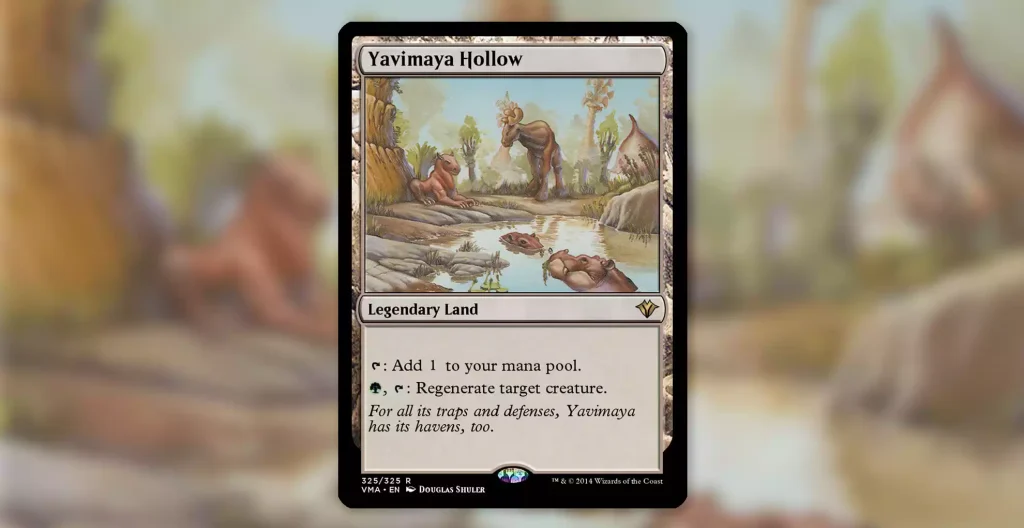
Why WotC Moved Away from Regeneration
Wizards of the Coast found regeneration too confusing for many players, particularly new ones. The idea that you must set up the effect in advance, that it removes your creature from combat, and that it doesn’t protect against certain forms of removal was enough to cause repeated rules misunderstandings.
Over time, WotC introduced simpler solutions:
- Indestructible – A permanent with indestructible can’t be destroyed by lethal damage or destroy effects. However, it’s still vulnerable to exile, sacrifice, or effects that reduce toughness to zero.
- Shield counters – These appeared in later sets. A shield counter also acts as a replacement effect against destruction. Once an effect would destroy the creature or lethal damage is dealt, you remove one shield counter instead. The creature remains. That’s somewhat simpler, as it doesn’t involve tapping or removing the creature from combat.
- Hexproof or Ward – While not directly replacing regeneration, these abilities reduce how often your opponent can target your creature, which can keep it alive.
In older sets, though, regeneration was a nice niche that gave some colors (particularly green and black) a way to keep creatures alive and avoid common removal. If you look at the original printing of cards like “Elvish Champion,” “Troll Ascetic,” or “Thrun, the Last Troll,” you’ll see that regeneration was a classic way to ensure those creatures stuck around.
Notable Cards with Regeneration
Thrun, the Last Troll
Thrun is difficult to remove with spells or abilities and can regenerate for {1}{G}. Its resilience makes it a powerful and sticky threat.
Troll Ascetic
Troll Ascetic has hexproof and can regenerate for {1}{G}. This combination makes it hard to interact with and a durable creature in combat.
Rakshasa Deathdealer
Rakshasa Deathdealer can pump its power and toughness by {1}{B}{G} and regenerate for {B}{G}, providing flexibility as a threat.
Loxodon Hierarch
Loxodon Hierarch regenerates all your creatures for {G}{W}. This effect can protect your board from destruction effects and keep you ahead.
Practical Tips and Final Thoughts
- Remember to Plan Ahead
- You can’t wait until the last second to regenerate. You need to have your shields up before the effect kills your creature.
- Watch Out for “Can’t Be Regenerated”
- Many removal spells include that phrase. It means your regeneration is useless.
- Be Aware of Combat Removal
- If you rely on your creature to block, you might want to keep mana open during the declare blockers step to activate or cast a regeneration effect.
- Interactions with Other Rules
- State based effects check if a creature has lethal damage. If it does, that’s when the game tries to destroy it. Make sure your regeneration is ready before that check.
- Removing It from Combat
- The trade-off for saving your creature is that you lose it in the fight for the rest of that turn.
- Multiple Shields
- In some rare cases, you can stack multiple regeneration shields if you expect more than one attempt to destroy your creature in a turn. For instance, if you think your opponent will cast “Shock” and “Lightning Bolt,” you might want more than one shield.
- Regeneration vs. Other Modern Mechanic
- Indestructible is simpler. Shield counters can be simpler as well. But if you enjoy the older style of gameplay, regeneration has its own charm.
- Legacy of Regeneration
- Although no longer printed in large numbers, regeneration remains a part of MTG’s rules. Cards that have it will always reference it, so it’s good to understand. It played a role in shaping how the game’s rules about destruction are structured. Its complexity is also a prime example of how MTG evolves: older mechanics sometimes get replaced by more streamlined approaches.
Wrapping Up
Regeneration in Magic: The Gathering is both simple and tricky at the same time. The core idea is straightforward: if something says, “Destroy this creature,” or if the creature is dealt lethal damage, you can regenerate it if you’ve set up a regeneration shield. That means tapping the creature, removing any lethal damage, and pulling it from combat. However, the timing involved—where you must set up the shield before the creature dies—and the fact that certain removal spells say “can’t be regenerated” can lead to misunderstandings.
Still, regeneration had a strong run in MTG. It offered an alternate effect to keep creatures alive. It shaped combat math, forced opponents to think carefully, and gave players a reason to keep mana open. Cards like Troll Ascetic, Thrun, the Last Troll, and many other older favorites made good use of it. Wizards eventually shifted design philosophy toward simpler solutions like indestructible, Ward, and shield counters, making regeneration a bit of a relic. But for those who still love older sets, or for Commander players who rely on synergy with black and green, these mtg regenerate rules can still be valuable.
Keep an eye out for any older card that has a creature’s regeneration ability or an effect that says “Regenerate target creature.” In a pinch, it can swing the outcome of a turn by protecting your key threat or letting you keep a vital blocking creature around for future attacks. The next time you see a player hold up one green mana, maybe they’re bluffing that they’ll just cast a pump spell or they might actually be planning to regenerate. And if you decide to include such spells in your deck, remember to practice the timing so you don’t miss your window.
Although regeneration sits in an odd place historically, it’s still recognized as a “nice niche” that some players appreciate. That small subset of the game’s rules stands as a reminder that Magic’s design is always changing. The lessons learned from how regeneration works led to new effects that are easier to grasp. But for many of us who played in older formats, or who still enjoy casual tables with older cards, regeneration’s flavor and tactical nuance remain a fun part of the MTG experience.
If you do build a deck with regeneration themes, you’ll have to weigh the regenerate mana cost against the flexibility you want each turn. You’ll also want to consider how best to tap or leave open your mana to protect your creatures. That extra step can be both a strength and a weakness, depending on how well you anticipate your opponent’s moves.
In the end, regeneration is about preventing your creature from destruction. You see a lethal event coming, you pay for the effect, and your creature is saved. Sometimes, you’ll get burned if your opponent has a spell that denies regeneration. Other times, your creature stands tall because you saw the danger in time. That’s the dance of strategy in Magic: balancing your resources and your knowledge of other rules to outmaneuver your opponent. For some, it’s worth it. For others, the new suite of protective mechanics is simpler. But regeneration still has a place in casual settings, older formats, and for those who like the quirky side of Magic’s history.
That’s how regeneration in MTG can still shape games. It’s an important piece of the rules that many players learn early on and either keep using or set aside for more modern mechanics. Either way, it’s good to understand how it works, just in case you ever see that old card text come across the table. And when that 2/2 with regenerate ends up surviving a big removal spell or stops a huge attacker in its tracks, you might just decide that old mechanics can still be a lot of fun.
Understanding a creature’s regeneration ability and how it can be used strategically to protect key creatures in the game is crucial.



